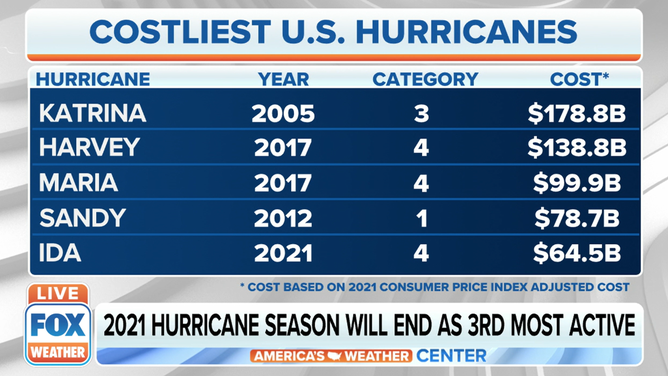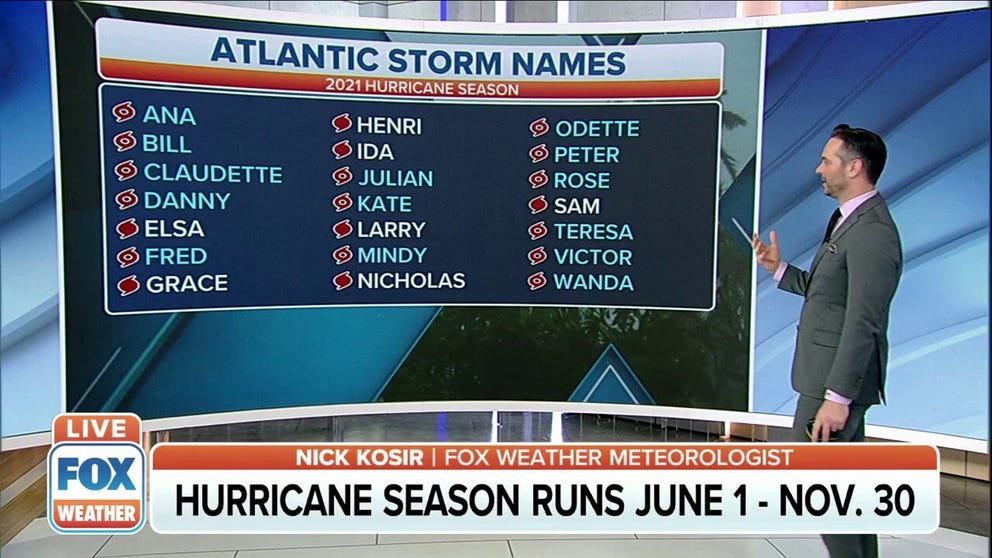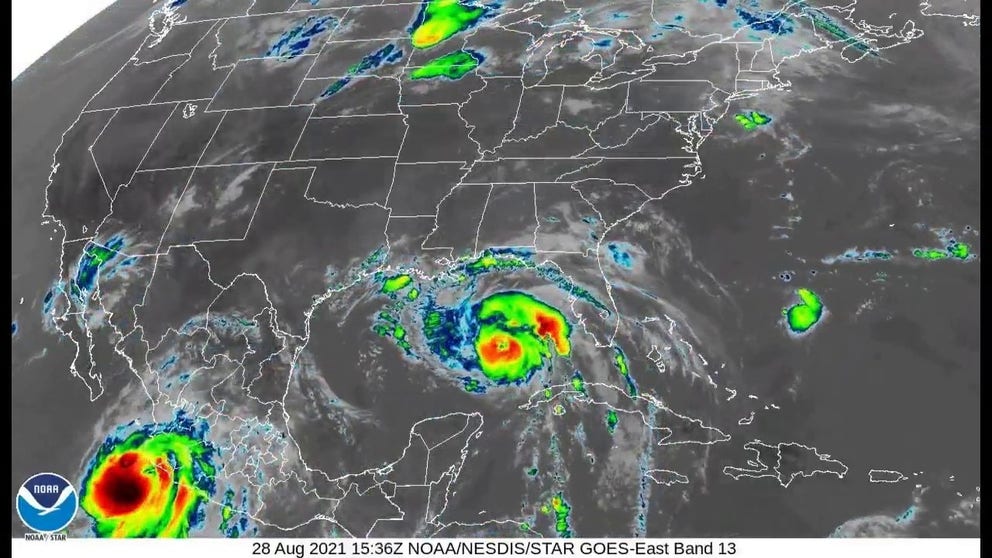2021 Atlantic hurricane season ends as third most active on record
The 2021 Atlantic hurricane season will come to end after Nov. 30
Atlantic 2021 hurricane season ends
As hurricane season wraps up on November 30th, FOX Weather takes a look back at the eventful Atlantic 2021 hurricane season.
The 2021 Atlantic hurricane season is not ending soon for residents of the Gulf Coast and the Eastern Seaboard, who are still picking up the pieces after experiencing the third-busiest hurricane season on record.
Barring an off-season formation, the year will go down as having produced 21 named storms and seven hurricanes, with four of those becoming major hurricanes (Category 3 or higher on the Saffir-Simpson Hurricane Wind Scale).
The year fell short of producing anywhere near the number of storms seen last year and back in 2005.

The 2021 hurricane season ranks third for having the most activity.
(FOX Weather)
Tampa’s FOX13 Chief Meteorologist Paul Dellegatto said besides the records, the season will also be known for its lopsidedness, with most of the tropical cyclones forming during the first half of the season.
"For the first time since 1950, from the end of October until today, there was not a major hurricane anywhere on the planet," Dellegatto said.
A hurricane that formed during the busy peak of the season was Hurricane Ida.
Ida made landfall near Port Fourchon, Louisiana, as a Category 4 hurricane on Aug. 29.
The storm tied historical records for being the strongest hurricane in the state’s history and had sustained winds around 150 mph at landfall.
HOW ARE HURRICANES RATED? THE SAFFIR-SIMPSON HURRICANE WIND SCALE EXPLAINED
Ida caused a path of destruction up the Eastern Seaboard, producing flooding and tornadoes as far north as New England.
"It’s going to rank about fifth as far as total storm damage goes, running about $65 to $75 billion," Dellegatto said.

Hurricane Ida was the fifth-costliest storm to impact the U.S.
(FOX Weather)
The storm was responsible for at least 96 deaths across eight states.
Ida was one of eight storms that made landfall in the United States in 2021, short of the record-breaking 11 that struck the continental U.S. in 2020.
Active start to season
For the seventh year in a row, the season began before the scheduled start of June 1. Subtropical Storm Ana formed on May 22 in the central Atlantic. The storm wasn’t around for a long time, but it did provide a reminder of the upcoming hurricane season.
HERE'S WHY THE ATLANTIC HURRICANE SEASON RUNS FROM JUNE TO NOVEMBER
The first U.S. strike during the 2021 season was from Tropical Storm Claudette. The system made landfall in Louisiana as a minimal tropical storm, but its impacts stretched into much of the Southeast. The storm produced tornadoes and heavy rains that were linked to more than a dozen fatalities.
The state of Florida received back-to-back strikes from tropical storms in the Gulf of Mexico. Tropical Storm Elsa made landfall in July, and Tropical Storm Fred followed a similar route into Florida in August. Both storms struggled to intensify over the eastern Gulf but produced tornadoes and flooding well inland.
Busy peak
Hurricane Grace kicked off the start of the significant tropical cyclones of the 2021 season. It was the first major hurricane of the year, reaching Category 3 status. The storm made two landfalls in Mexico and is estimated to have caused more than a half-billion dollars in damage.
At the same time Grace threatened Central America, Hurricane Henri churned in the western Atlantic. Luckily for the Northeast, the storm weakened to a tropical storm before making landfall in Rhode Island. Before the storm, the Northeast was already on track to see one of its wettest summers on record. Henri’s rainfall triggered flooding from New York to Massachusetts.
Meteorologists say the headline storm followed, with the destruction left behind by Hurricane Ida. Ida formed in the northwestern Caribbean Sea and rapidly intensified into a Category 4 hurricane before its Louisiana landfall. Ida’s 150-mph winds knocked out power for several weeks in portions of the state. The storm’s remnants remained destructive into the Northeast, producing tornadoes and widespread flooding. Flash Flood Emergencies were declared in New Jersey and New York for the first time, as some areas saw more than 10 inches of rain.
EXPLAINING FLOOD ALERTS ISSUED BY THE NATIONAL WEATHER SERVICE
Hurricane Ida Satellite
Hurricane Ida was the strongest cyclone to make landfall in the U.S. during the 2021 season.
Right on cue, 11 named storms formed during the period from Aug. 28 until Sept. 29. September is statistically the busiest month for tropical cyclone activity, and 2021 lived up to climatology.
The peak of the season did produce the year's strongest storm. Hurricane Sam reached Category 4 status, with sustained winds of 155 mph and a pressure of 929 millibars. Luckily for coastal areas, the major hurricane remained well out to sea in the central Atlantic and mainly was just a concern to shipping interests.
Despite the activity, the season was the second in a row to not have a Category 5 hurricane.
Quiet ending
Meteorologists only tracked three tropical systems during the months of October and November.
The lull in activity was quite different from the record-breaking seven named storms that formed during the same time period in 2020.
THE BEASTS OF THE ATLANTIC: 93 HURRICANE OR TROPICAL STORM NAMES HAVE BEEN RETIRED
Tropical storms Victor and Wanda rounded out the final two names on the season’s list.
Unlike the 2020 hurricane season, the year did not require meteorologists to use names from an additional list.
While the number of named storms ran well above average in 2021, the number of hurricanes and major hurricanes ended near what an average season brings.

The 2021 hurricane season was more active than an average year.
(FOX Weather)

